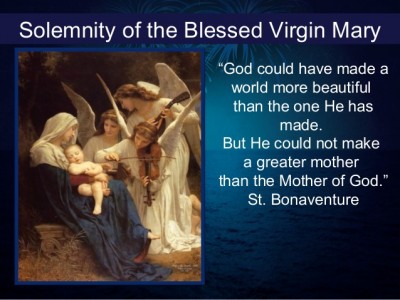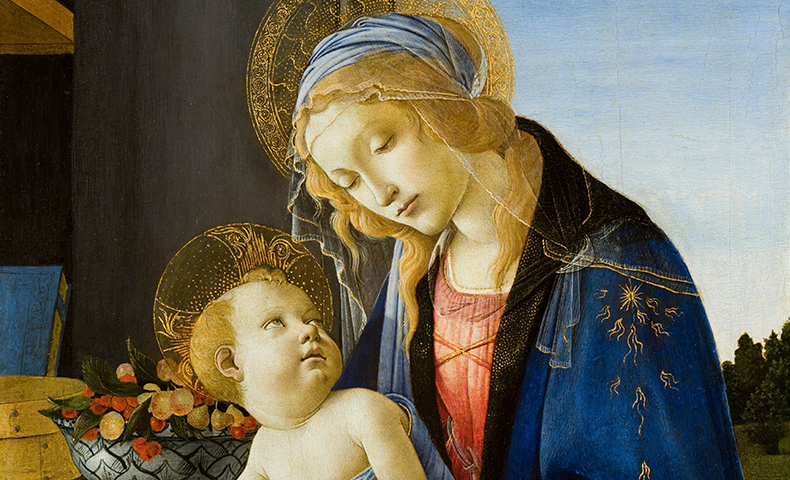The Story of Mary, Mother of God
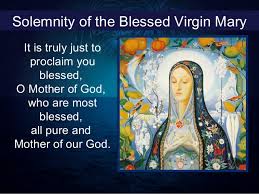
"The Solemnity of Mary, Mother of God is a liturgical celebration observed on January 1st. It is a holy day of obligation for Catholics, meaning that Mass attendance is required (though the Mass obligation is sometimes waived by the bishop for various reasons; when in doubt, check with your parish.)
The use of the word “Solemnity” here is not a statement about Mary’s personality. It is a designation used for certain days within the liturgical (church-based) calendar of the Church. Solemnities are the highest rank of liturgical celebration, higher than feast days or memorials. By celebrating a solemnity dedicated to Mary’s motherhood, the Church highlights the significance of her part in the life of Jesus, and emphasizes that he is both human and divine.
Though New Year’s Day may seem more like a day for football and hangovers than for Mary, there’s a beautiful spiritual significance in celebrating her during the heart of the Christmas season. Pope Paul VI, in his apostolic exhortation Marialis Cultus (1974), called the Solemnity of Mary “a fitting occasion for renewing adoration of the newborn Prince of Peace, for listening once more to the glad tidings of the angels (cf.Lk 2:14), and for imploring from God, through the Queen of Peace, the supreme gift of peace.”"
Article from Franciscian Media
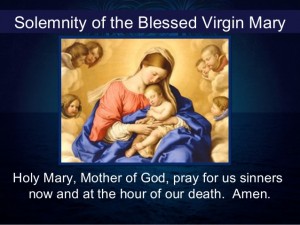 "Mary’s divine motherhood broadens the Christmas spotlight. Mary has an important role to play in the Incarnation of the Second Person of the Blessed Trinity. She consents to God’s invitation conveyed by the angel (Luke 1:26-38). Elizabeth proclaims: “Most blessed are you among women and blessed is the fruit of your womb. And how does this happen to me, that the mother of my Lord should come to me?” (Luke 1:42-43, emphasis added). Mary’s role as mother of God places her in a unique position in God’s redemptive plan.
"Mary’s divine motherhood broadens the Christmas spotlight. Mary has an important role to play in the Incarnation of the Second Person of the Blessed Trinity. She consents to God’s invitation conveyed by the angel (Luke 1:26-38). Elizabeth proclaims: “Most blessed are you among women and blessed is the fruit of your womb. And how does this happen to me, that the mother of my Lord should come to me?” (Luke 1:42-43, emphasis added). Mary’s role as mother of God places her in a unique position in God’s redemptive plan.
Without naming Mary, Paul asserts that “God sent his Son, born of a woman, born under the law” (Galatians 4:4). Paul’s further statement that “God sent the spirit of his Son into our hearts, crying out ‘Abba, Father!’“ helps us realize that Mary is mother to all the brothers and sisters of Jesus.
Some theologians also insist that Mary’s motherhood of Jesus is an important element in God’s creative plan. God’s “first” thought in creating was Jesus. Jesus, the incarnate Word, is the one who could give God perfect love and worship on behalf of all creation. As Jesus was “first” in God’s mind, Mary was “second” insofar as she was chosen from all eternity to be his mother.
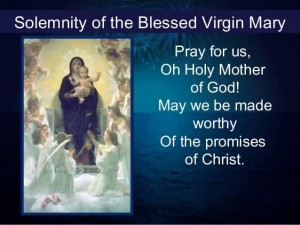
The precise title “Mother of God” goes back at least to the third or fourth century. In the Greek form Theotokos (God-bearer), it became the touchstone of the Church’s teaching about the Incarnation. The Council of Ephesus in 431 insisted that the holy Fathers were right in calling the holy virgin Theotokos. At the end of this particular session, crowds of people marched through the street shouting: “Praised be the Theotokos!” The tradition reaches to our own day. In its chapter on Mary’s role in the Church, Vatican II’s Dogmatic Constitution on the Church calls Mary “Mother of God” 12 times.
Reflections
Other themes come together at today’s celebration. It is the Octave of Christmas: Our remembrance of Mary’s divine motherhood injects a further note of Christmas joy. It is a day of prayer for world peace: Mary is the mother of the Prince of Peace. It is the first day of a new year: Mary continues to bring new life to her children—who are also God’s children."
To learn more about the story of Mary and why Catholics celebrate her, visit Vatican Radio's webpage.
